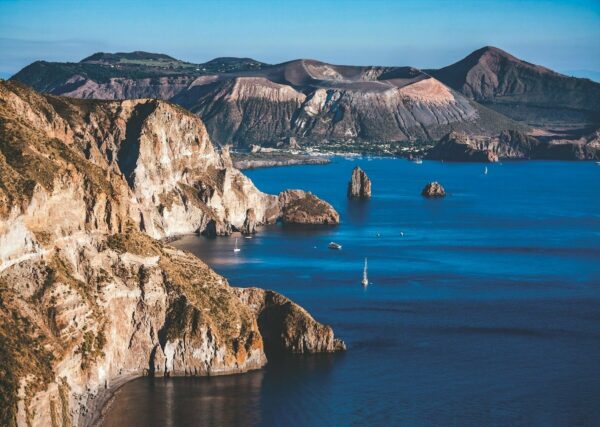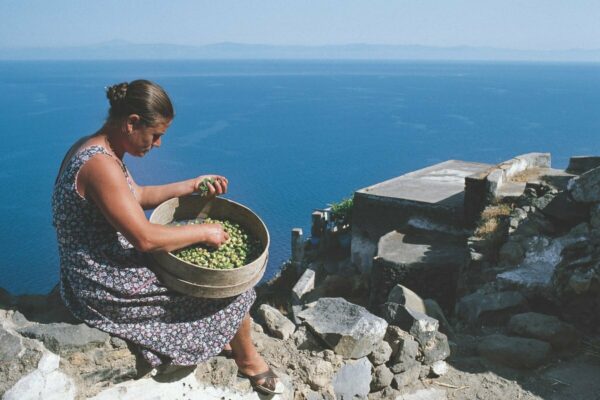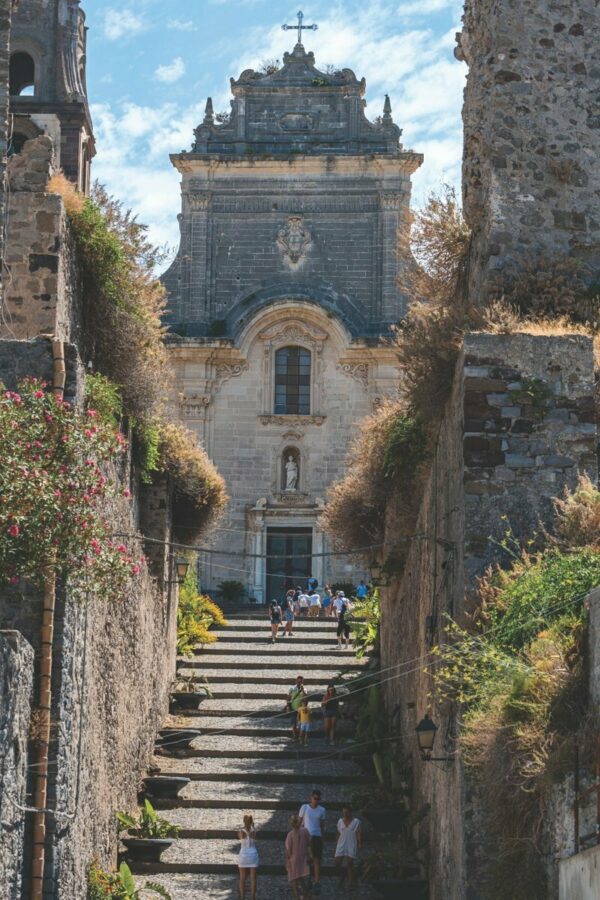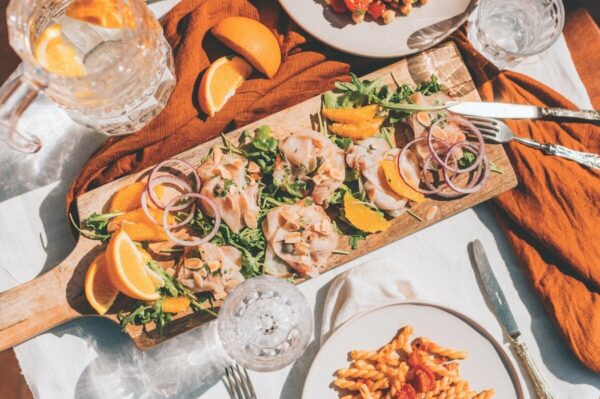Anchovies and Volcanic Beauty
Bill Knott tells us just why he loves the Aeolian Islands in all their culinary glory

By Bill Knott
July 6 2023
This April, Ranald and I hosted the “Boisdale Aeolian Odyssey”, welcoming 24 delightful guests – all Boisdale regulars – on a thoroughly bespoke tour of the archipelago. Based on Salina, we spent a wonderful week as the sole occupants of the beautiful Hotel Principe di Salina, while our privately-chartered boat, Lady Salina, was on standby for a gloriously sybaritic tour of other islands – all volcanic, some more so than others.
“He’s looking a bit nervous,” our captain said one day, pointing at Stromboli, 30 kilometres to the northeast, as a horizontal plume of smoke drifted towards us.
Volcanoes are an understandable preoccupation for the 15,000 residents of this archipelago just north of Sicily. The Aeolian Islands are a UNESCO World Heritage Site, recognised for their importance to vulcanology: two distinct kinds of eruption, Vulcanian and Strombolian, take their names from here.
The volcanic peaks of Salina, however, have been silent for many millennia, their bedrock of white pumice and black obsidian now carpeted in grass and wild fennel. A few kilometres to the southeast, the island of Lipari, although still classed as volcanically active, is similarly tranquil, while the main disruptions on Panarea, the smallest of the seven inhabited islands, are the parties thrown by the thousands of well-heeled visitors who arrive each summer. Avoid July and August, however, and it is the perfect spot to enjoy stunning sea views and a quiet charm.
For those who seek utter serenity, meanwhile, the islands of Filicudi and Alicudi offer just a scattering of villas among the stunted olives, straggling vines and wild rosemary. Jump off the boat for a swim in Filicudi’s sapphire clear waters before having lunch at Grand Hotel La Sirena (which features four lovely bedrooms but is not remotely grand), or continue to tiny Alicudi, clamber up a few steps from the harbour, and feast on fresh seafood.

Some summer visitors arrive by private yacht, and a few by helicopter, but most make the hydrofoil trip from Milazzo, on Sicily’s north coast. Once installed in a hotel or a villa, boats – with or without a skipper – are easy to charter. When you have struck base on one of the two largest islands, Lipari and Salina, island-hopping is a delight: each has its own character, but they share a laid-back hospitality, and– this being Italy – plenty of excellent food and drink.
While the sybaritic delights of beaches, water sports, bars and restaurants are the priority for most visitors (as well as the obligatory sunset boat trip to marvel – from a judicious distance – at Stromboli’s fireworks) the islands also fascinate with their culture and history, as a visit to the excellent archaeological museum in Lipari, housed in an old Benedictine abbey, will confirm.
The Aeolian Islands first tasted prosperity in the Bronze Age, as part of the maritime trade routes that stretched as far as southern Britain; more recently, the archipelago’s photogenic qualities have lured many filmmakers, among them Roberto Rossellini (for the neo-realist Stromboli, starring Ingrid Bergman) and Michelangelo Antonioni (for L’Avventura, with Monica Vitti), while some of the scenes in Michael Radford’s Il Postino are set in Pollara, on Salina.
Pollara is also home to a caper festival every June, although you could be forgiven for thinking that these little green buds are a cause for year-round celebration throughout the archipelago. They appear on every menu and many market stalls, along with caper berries (known locally as cucunci) and caper leaves, packed in sea salt which, on Salina, would once have come from the now-disused salt pans at Lingua that gave the island its name.

The capers crop up everywhere, adding a unique tang to la cucina eoliana: in the local versions of the Sicilian caponata; in sauces for the superb local fish and pasta; even – and it merits the trip to Papero in Rinella, on Salina’s south coast just to try it – candied, in a ricotta granita, with a dusting of toasted caper powder on top. The rest of Papero’s menu is excellent, too: try the Stromboli- shaped arancini and the fish of the day, sauced Sicilian-style with sweet-sour onions and raisins.

Unpretentious, family-run restaurants can be found on every island, from agriturismi hidden in hillsides to beachside trattorias in fishing villages. The local wines are worth trying, too, especially Malvasia delle Lipari, traditionally honey-sweet but increasingly made in a dry style that perfectly partners a long, lazy lunch.
Lipari has the best selection of smarter restaurants: Filippino has been serving the freshest of fish since 1910, while L’Anfora serves classic Aeolian dishes with old-school charm. The islands even boast two Michelin stars: for Signum’s Martina Caruso on Salina and Il Cappero’s Giuseppe Biuso on Vulcano.
But whatever you eat, from an elegant tasting menu on a lofty terrace to a simple plate of pasta and a pistachio granita by the water’s edge, it is the islands themselves – the fragrance of wild fennel and lemon groves, the colourful splashes of bougainvillea, prickly pears and caper flowers, the gentle lapping of crystal waters on volcanic shores – that are the real feast for the senses.

Where to Stay & Eat
SALINA
Hotel Principe di Salina (****)
A delightful, family-run hotel with stunning views of Stromboli, terrific food and a lovely pool, where the Boisdale brigade stayed
Hotel Signum (****)
A cluster of understated, elegant and airy rooms in a terrific location, with a secluded pool, spa and Michelin-starred restaurant
Da Alfredo
By the salt pans in Lingua: simple dishes and a famously superb array of granita
Ristorante Porto Bello
Lovely, simple-but-stylish fish restaurant overlooking Santa Marina’s harbour
LIPARI
Hotel Mea (****)
A short walk from the port, with a pool overlooking the ocean and a smart restaurant
Mancia e Fui
Translates (politely) as “eat and go away”: excellent Sicilian-style street food
PANAREA
Hotel Raya (*****)
Chic lodgings for the rich and famous, and the perfect spot for an aperitivo by the pool.
The Bridge
Local legend Angela Mascolo’s nightspot-cum- sushi bar: the place to see-and-be-seen.
VULCANO
Therasia Resort & Spa (*****)
Glamorous and romantic five star hotel perched on Vulcano’s northernmost cliffs. Fabulous views and Michelin-starred cuisine.
Trattoria Da Pina
On the south of the island, in the tiny fishermen’s village of Gelso: a perfect little restaurant with superb seafood
